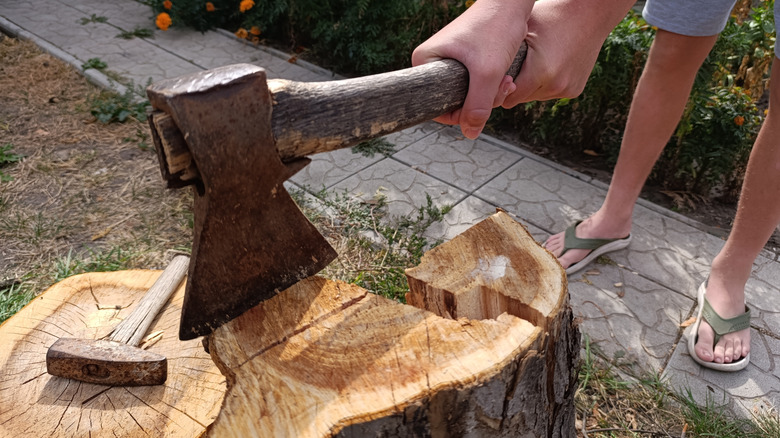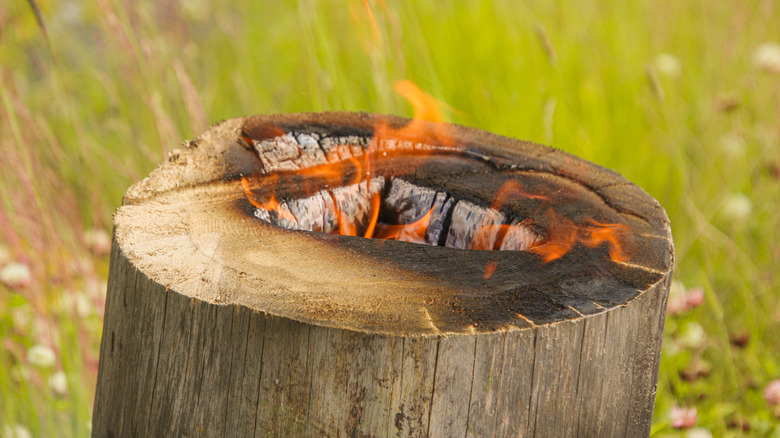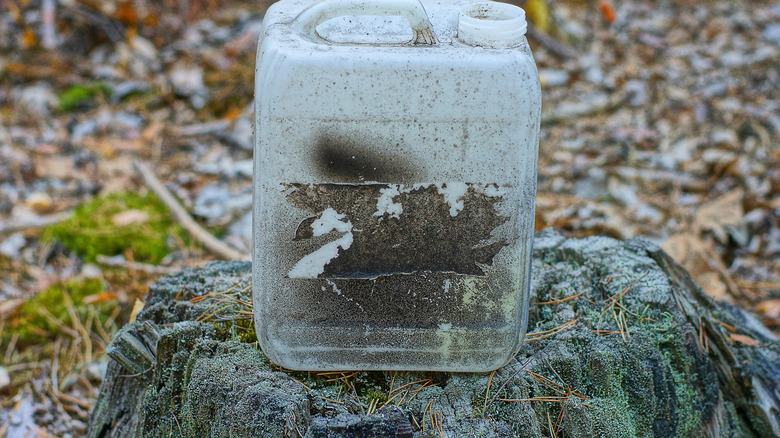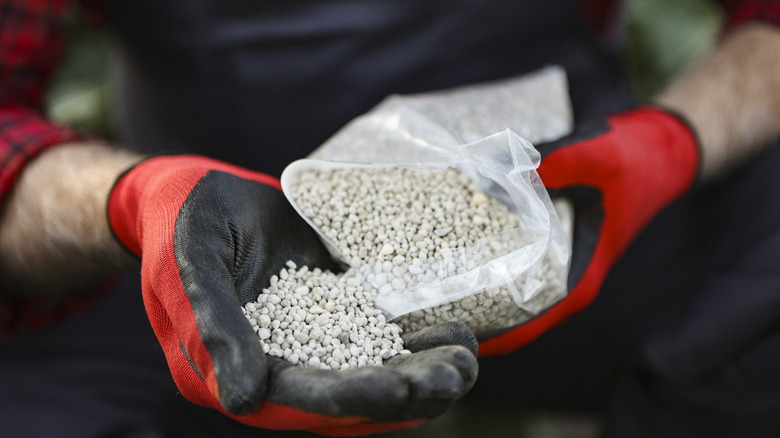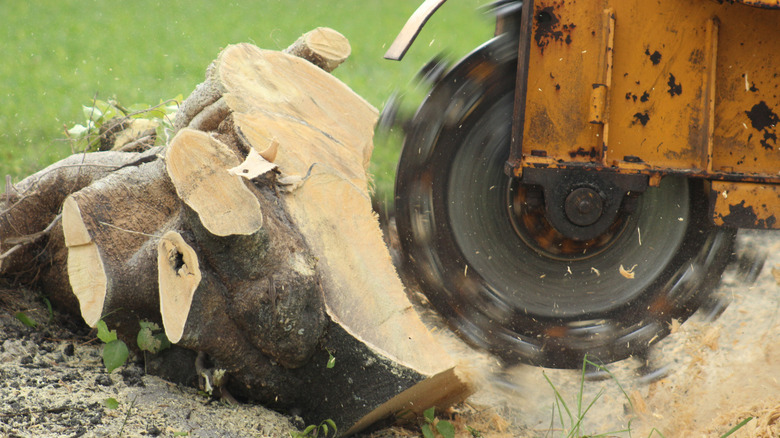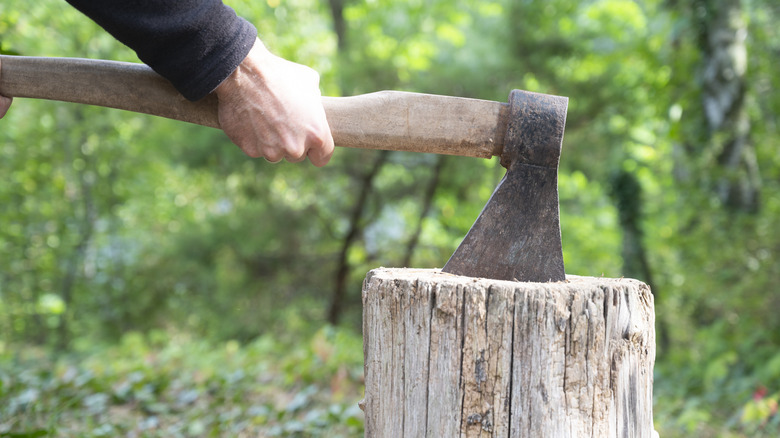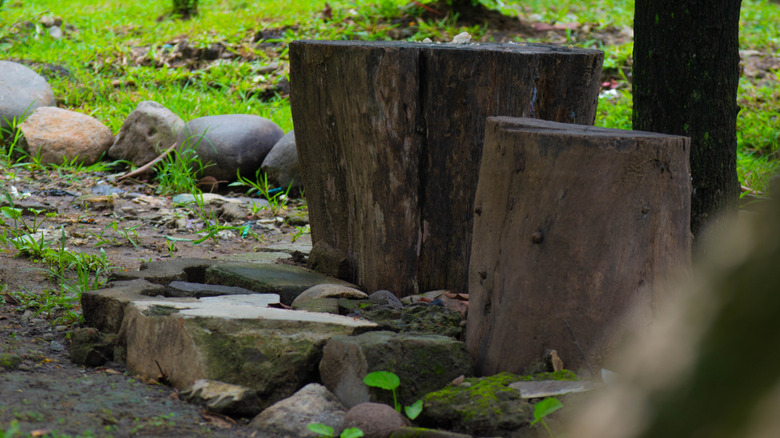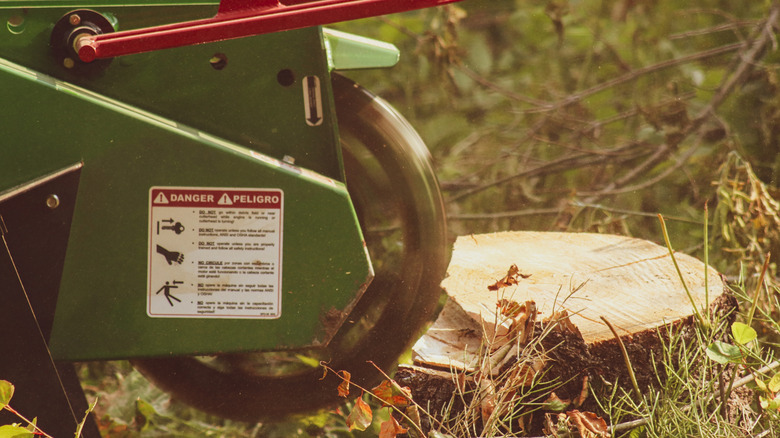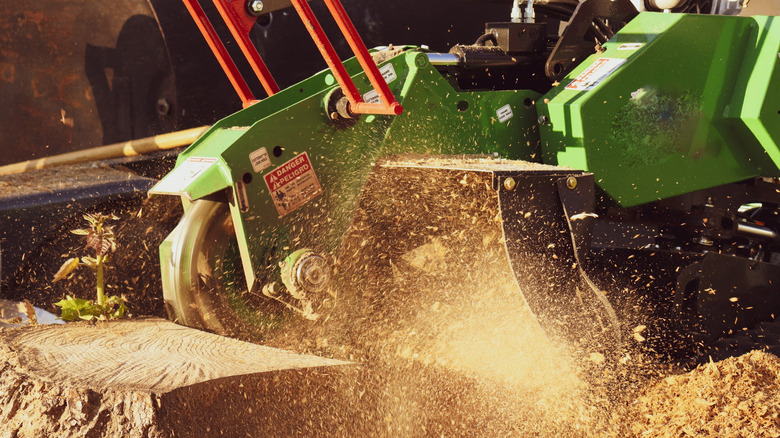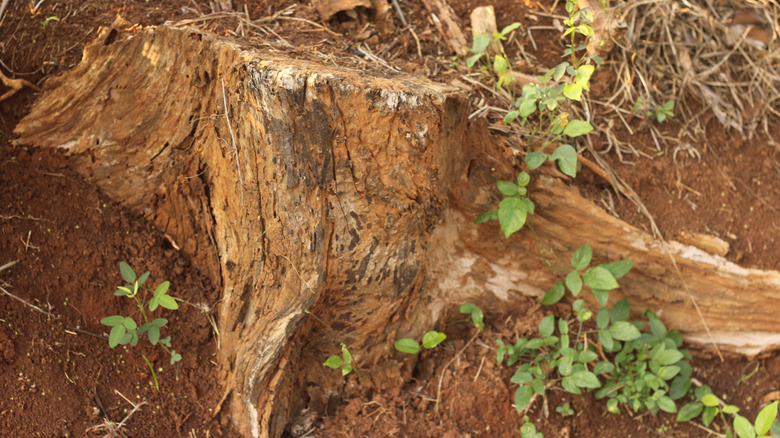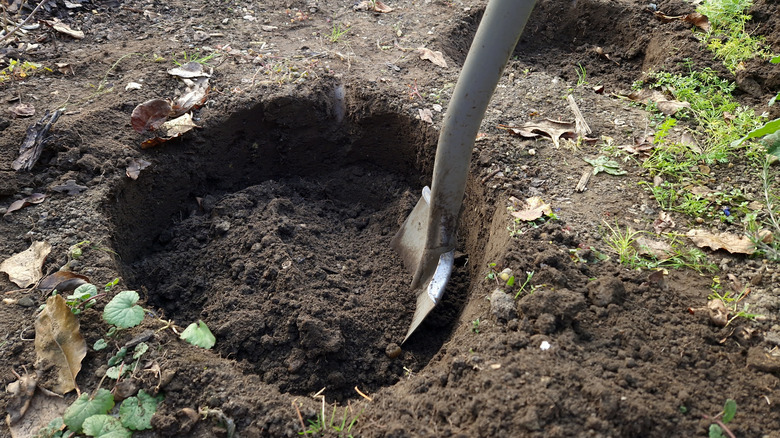Mistakes Everyone Makes When Removing A Tree Stump From Their Yard
So, you found signs that tree removal is the right decision for your yard, but now you're left with a stump. Perhaps, the supposed sentinel had turned into a host for fungal diseases, endangering your orchard. Maybe you inherited the tree from the previous homeowner and want it removed because it had simply grown too large. Or maybe a storm took down the tree. Whatever the reason, after deciding to call in a tree service and you probably received a shock when they stated that removing the stump costs a good chunk of extra money. The horror! What's even worse is that you can't retain the stump if it has a history of serious disease. Other reasons you may need to have it gone include interference with mowing — a stump can be 4 feet tall, after all. Or, it could be worsening your yard's pest infestation by harboring rodents. In short, that stump must go.
While there are several ways to proceed with stump removal, they may go wrong if you don't watch for some common missteps. It can be tempting to burn the rotting stump, but you could be flouting local ordinances. Similarly, turning to chemical removers may be a poor call in some cases, considering their toxicity. Skipping protective gear, not clearing the area beforehand, or using the wrong tools are other common follies. To help you better navigate the stump removal process, we've discussed below some of the major mistakes DIYers are guilty of making, but must avoid for effective results.
Not checking the local ordinances before stump removal via fire
Theoretically, burning might feel like the best way to get rid of pesky tree stumps. Save for some fuel and time, you aren't making any other significant investment. However, going down this route can get you into trouble with law enforcement if you haven't checked the state regulations, county laws, and local ordinances. To illustrate, Indiana has disallowed the open burning of tree stumps, while Wisconsin allows it if the method complies with their Air Program's requirements. Likewise, Florida allows open burning, provided you've got the Florida Forest Service's authorization and meet any required location and burn time restrictions. Municipalities may pose similar burning restrictions within the city limits, necessitating adherence to the local laws. Burn bans in counties are another consideration, particularly during the wildfire season.
So, checking local laws and ordinances and consulting with the local fire officials is essential before setting any tree stumps on fire. Even with approvals in hand, ensure you aren't putting the match to the stump when it's surrounded by flammable materials (like other plants and trees); otherwise, the fire may spread. Also, steer clear of petrol or gasoline, as it can be hazardous and polluting. If you do opt to burn, it's advised to place an open-bottom, perforated container (like a 5-gallon metal drum) over the stump and place charcoal inside. This can help contain and concentrate the fire, which has to be relatively hot to burn the moist wood of the stump. While we're on the topic of laws and regulations around stump removal, note that you might also require permits for stump grinding in certain situations where the environment is at risk (like wetlands), or where noise pollution and utility disruption are a cause for concern.
Using copper sulfate to burn the stump chemically
Some homeowners resort to chemicals like copper sulfate to remove a tree stump. The aim is to degrade the wood quickly with the chemicals and burn the remnants afterward (if required). However, this may be a major mistake, given the risks involved. Copper sulfate is corrosive to living tissue and equally hazardous on inhalation. So, you must be very careful during application, follow the label's safety instructions, and ensure your kids and pets don't venture into the area. What's even more concerning is that copper sulfate is highly polluting. If it leaches into the ground, it can kill the surrounding vegetation, including trees, shrubs, and lawn grass by targeting their roots — clearly, an unwelcome outcome. Plus, as these chemical removers require multiple applications (and may not even work for bigger stumps), the probability of harm increases significantly.
Moreover, copper sulfate is toxic to birds. This can become problematic if the feathered creatures are nesting inside the stump's cavities. Aquatic life, especially fish, cannot tolerate copper sulfate either. So, using it on stumps near lakes, wetlands, ponds, or any other water source can damage the environment. Given that, a better option would be to repurpose the old tree stump in your yard into a bird feeder or a planter by hollowing it out. Alternatively, you can try to remove a tree stump with Epsom salt – a much gentler ingredient.
Adding excessive amounts of fertilizer to the stump to encourage rotting
Another popular method to safely remove a tree stump without calling in the professionals is to allow it to rot. Although this method is time-intensive, it requires little investment, as you're depending on the soil fungi to degrade the stump. Many gardeners pour nitrogen fertilizer (or a mix of nitrogen and phosphorus) into the stump to accelerate the degradation process after the stump has been axed close to the ground. As long as the stump and the soil it sits on remain moist, the fungi will feed on the fertilizer, multiply, and continue breaking down the stub. But if you use excessive amounts of fertilizer, it works conversely, derailing all progress. That's because, like plants, fungi suffer from overfertilization. For this reason, you must never spread the fertilizer in thick layers (or worse, dump it in a large lump).
Instead, drill 10-inch deep, 1-inch wide holes (about 1 foot apart) into the stump and fill each hole with roughly 4 ounces of nitrogen-based, slow-release fertilizer. Reapply only when the previous amount has dissolved fully. Avoid hosing the stump to keep the area moist, as this can wash off the fertilizer. Instead, consider misting the area and covering it with organic mulch or fully composted manure for better moisture retention. You can also build a compost pile over the site or a raised bed to hide the stump and help keep it moist. While these methods can totally work, do note that it'll take multiple years for the stump to degrade — so if you're looking for a quick fix, this isn't it.
Picking the wrong equipment for the site or the tree stump's size
Another mistake that's easy to make when removing a tree stump is picking the wrong method or tools. For instance, a rented stump grinder can save you the cost of hiring a professional stump removal company, and be relatively straightforward to operate in a flat yard — but using it on sloped sites can get tricky and dangerous, and is not recommended. Conversely, if you've got a bog for a garden or a flooded yard, applying fertilizer might yield poor results if the nutrients just get washed away. Even stump grinding will be a poor choice in this case, as the equipment can compact the soil, making conditions unfavorable for most ornamentals.
Also, pay heed to the type of tree stump and its size before picking your tools. For instance, DIYing stump removal with rented equipment for a large hardwood tree is a surefire way to set yourself up for failure, though it may work for softwood species. Stumpers are also inappropriate for young trees, as they're designed for mature tree trunks. For this reason, under 15-inch wide stumps are typically removed using tools like brush saws, loppers, shovels, machetes, handsaws, or grub hoes. For stems that are too thick to cut by hand or with a brush cutter — but still too small to warrant a stumper, you try using a chainsaw.
Not wearing safety gear during stump removal
When it comes to stump removal, safety is utmost. Unfortunately, many homeowners regularly use cutting tools, like shovels, loppers, or axes, in their garden and ignore the precautions — often at their own peril. Regardless of the tool being used, there's a risk that the chipped or ground wood pieces will fly out while you're hard at work. To guard against these strays, wear protective gear throughout the process. A respirator will shield you from the carcinogenic exhaust fumes from any gas-powered equipment.
Specifically, don a hard helmet, safety glasses (or goggles), face shield, and tough gloves. Protect yourself against the projectiles with thick long-sleeve shirts, full-length pants, and safety boots, or the flying debri might lodge into your skin. As stump grinders can be loud, use ANSI-approved ear protection to safeguard your hearing. You can also drop a protective shield around the stump to stop flying pieces from hitting anyone nearby. Finally, don't forget to send your children and furry friends indoors before starting on stump extraction.
Not clearing out the area before stump excavation
Not preparing the area before you start stump grinding is another mistake homeowners are guilty of making. Trees often stand over critical water lines, drainage systems, gas lines, or electrical components, so when you're sawing them down and excavating their stumps, there's a high probability that these underground systems may come to harm, resulting in floods or fires. Given this, it's best to consult with the local officials and mark the areas where utility lines pass before commencing work.
Simultaneously, you must clear the excavation site of all rocks, stones, brush, logs, and debris. Removing rocks from around the tree base is especially important, as not doing so will wear down the grinder's teeth, reducing efficiency and necessitating expensive replacements. The blades can also fling out rocks they encounter, which is about as dangerous as it sounds. Rocks can also create a fire hazard with the stones striking and sparking against the cutting blades (if you're getting flashbacks to the Stone Age, you're not alone). This is particularly concerning in dry sites. Finally, consider delaying stump removal until after bird nesting and breeding season ends to avoid disrupting your backyard visitors.
Not grinding down the stump deep enough
During stump grinding, you must pulverize the leafless stub to a depth of 8-12 inches and remove the surface roots. You may need to go deeper for invasive tree species, and even then they might resprout. Besides preventing resprouting, grinding down below the soil surface also means you can successfully convert that into turf or a garden bed.
Put simply, the more roots and stump that remains in the ground, the more chance there can be of regrowth. Even if they don't resprout, a shallow-ground stump and residual old roots can deny replacement trees or shrubs adequate berth to put down their roots. As leftover surface roots decompose, they could also cause dents, bumps, and dimples in the ground, marring the yard's aesthetic. Given these facts, it's important that you don't make the mistake of grinding too shallow.
Employing the wrong technique during stump grinding
Although stump grinding is considered to be a simple and effective means of getting rid of the rotting stump in your yard, a lot can go wrong if you don't follow the right technique. For starters, if the stump is taller than 6 inches, you're better off sawing it down to ground level than trying to take off this length with the stump grinder. If you try to tackle a tall stump with the grinder, the entire process will take more time (and labor) to finish.
Moreover, while using a traditional grinder (the one with a vertical wheel on the front commonly found at The Home Depot and other box stores), make sure to run it from side to side for best results. Unless the manufacturer's instructions advise differently, at no time, should you chip away more than 3 inches from the stump in one pass. Doing otherwise could slow down or jam the engine.
Not using or delaying herbicide treatments for invasive tree stumps
Cutting down a woody tree doesn't ensure its immediate death. Keen on making a comeback, its stump may start producing suckers, leaving you with an unwieldy problem. Invasive trees like autumn olive and honeysuckle are the worst offenders, although non-invasive specimens like green ash, maples, crabapples, and poplars can be equally challenging. Manually cutting down or mowing off suckers to diminish their food stocks isn't a practical option for a lot of invasive species — it can take close to a decade, for the tree to eventually die. This leaves us with herbicidal treatment (known as cut stump treatment) to banish the suckers for good.
Since stumps seal themselves almost immediately, they should be treated right after tree removal. If not, you'll need to slice off a section to expose the live cambium layer and apply a glyphosate- or triclopyr-based brush killer (be careful during application, since these products can kill your non-target plants and grass, too). Any further delays may necessitate applying the herbicide to all exposed parts, including roots and the bark. Depending on the tree species, you may need to repeat the process if shoots still appear. Cut stump treatments shouldn't be carried out during spring, because tree sap actively flows upwards around this time and won't allow the herbicide to move systemically. Therefore, you should delay the task to late summer or fall when they leaf out.
Not disposing of the debris post stump removal and backfilling the hole
One final mistake that you shouldn't be making after grinding down a tree stump is putting off the disposal of the debris, especially the sawdust. As these shavings have a high carbon content, they can alter the soil's profile. This eventually prevents the replacement trees and shrubs from absorbing nitrogen, stalling their growth. Moreover, as this debris breaks down in the soil, it can cause the ground to sink, creating unsightly depressions and tripping hazards.
Given these reasons, make it a point to remove and compost or otherwise dispose of the wood shavings, roots, and leaves. Since they're newly cut, they'll still be fresh and easier to remove. Afterward, pack the cratered hole with a fresh layer of topsoil, so it doesn't subside down the road. Top things off with some compost and mulch if you wish to replant the area. Span the new plants around 3 feet away from the stump excavation site to ensure proper resource access.
